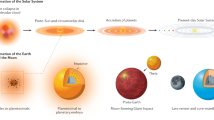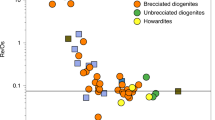Abstract
Terrestrial planets are thought to have formed through collisions between large planetary embryos1 of diameter ∼1,000–5,000 km. For Earth, the last of these collisions involved an impact by a Mars-size embryo that formed the Moon 50–150 million years (Myr) after the birth of the Solar System2,3. Although model simulations of the growth of terrestrial planets can reproduce the mass and dynamical parameters of the Earth and Venus, they fall short of explaining the small size of Mars4,5. One possibility is that Mars was a planetary embryo that escaped collision and merging with other embryos1. To assess this idea, it is crucial to know Mars’ accretion timescale6, which can be investigated using the 182Hf–182W decay system in shergottite-nakhlite-chassignite meteorites6,7,8,9,10. Nevertheless, this timescale remains poorly constrained owing to a large uncertainty associated with the Hf/W ratio of the Martian mantle6 and as a result, contradicting timescales have been reported that range between 0 and 15 Myr (refs 6–10). Here we show that Mars accreted very rapidly and reached about half of its present size in only  Myr or less, which is consistent with a stranded planetary embryo origin. We have found a well-defined correlation between the Th/Hf and 176Hf/177Hf ratios in chondrites that reflects remobilization of Lu and Th during parent-body processes. Using this relationship, we estimate the Hf/W ratio in Mars’ mantle to be 3.51 ± 0.45. This value is much more precise than previous estimates, which ranged between 2.6 and 5.0 (ref. 6), and lifts the large uncertainty that plagued previous estimates of the age of Mars. Our results also demonstrate that Mars grew before dissipation of the nebular gas when ∼100-km planetesimals, such as the parent bodies of chondrites, were still being formed. Mars’ accretion occurred early enough to allow establishment of a magma ocean powered by decay of 26Al.
Myr or less, which is consistent with a stranded planetary embryo origin. We have found a well-defined correlation between the Th/Hf and 176Hf/177Hf ratios in chondrites that reflects remobilization of Lu and Th during parent-body processes. Using this relationship, we estimate the Hf/W ratio in Mars’ mantle to be 3.51 ± 0.45. This value is much more precise than previous estimates, which ranged between 2.6 and 5.0 (ref. 6), and lifts the large uncertainty that plagued previous estimates of the age of Mars. Our results also demonstrate that Mars grew before dissipation of the nebular gas when ∼100-km planetesimals, such as the parent bodies of chondrites, were still being formed. Mars’ accretion occurred early enough to allow establishment of a magma ocean powered by decay of 26Al.
This is a preview of subscription content, access via your institution
Access options
Subscribe to this journal
Receive 51 print issues and online access
$199.00 per year
only $3.90 per issue
Buy this article
- Purchase on Springer Link
- Instant access to full article PDF
Prices may be subject to local taxes which are calculated during checkout


Similar content being viewed by others
References
Chambers, J. E. & Wetherill, G. W. Making the terrestrial planets: N-body integrations of planetary embryos in three dimensions. Icarus 136, 304–327 (1998)
Canup, R. M. & Asphaug, E. Origin of the Moon in a giant impact near the end of the Earth’s formation. Nature 412, 708–712 (2001)
Touboul, M., Kleine, T., Bourdon, B., Palme, H. & Wieler, R. Late formation and prolonged differentiation of the Moon inferred from W isotopes in lunar metals. Nature 450, 1206–1209 (2007)
Wetherill, G. W. Why isn’t Mars as big as Earth? Lunar Planet. Sci. XXII, 1495–1496 (1991)
Raymond, S. N., O’Brien, D. P., Morbidelli, A. & Kaib, A. Building the terrestrial planets: constrained accretion in the inner solar system. Icarus 203, 644–662 (2009)
Nimmo, F. & Kleine, T. How rapidly did Mars accrete? Uncertainties in the Hf-W timing of core formation. Icarus 191, 497–504 (2007)
Kleine, T., Mezger, K., Münker, C., Palme, H. & Bischoff, A. 182Hf-182W isotope systematics of chondrites, eucrites, and martian meteorites: chronology of core formation and early mantle differentiation in Vesta and Mars. Geochim. Cosmochim. Acta 68, 2935–2946 (2004)
Foley, C. N. et al. The early differentiation history of Mars from 182W-142Nd isotope systematics in the SNC meteorites. Geochim. Cosmochim. Acta 69, 4557–4571 (2005)
Jacobsen, S. B. The Hf-W isotopic system and the origin of the Earth and Moon. Annu. Rev. Earth Planet. Sci. 33, 531–570 (2005)
Kleine, T. et al. Hf-W chronology of the accretion and early evolution of asteroids and terrestrial planets. Geochim. Cosmochim. Acta 73, 5150–5188 (2009)
Righter, K. & Shearer, C. K. Magmatic fractionation of Hf and W: constraints on the timing of core formation and differentiation in the Moon and Mars. Geochim. Cosmochim. Acta 67, 2497–2507 (2003)
Bouvier, A., Blichert-Toft, J. & Albarède, F. Martian meteorite chronology and evolution of the interior of Mars. Earth Planet. Sci. Lett. 280, 285–295 (2009)
Blichert-Toft, J. & Albarède, F. The Lu-Hf isotope geochemistry of chondrites and the evolution of the mantle-crust system. Earth Planet. Sci. Lett. 148, 243–258 (1997)
Bouvier, A., Vervoort, J. D. & Patchett, P. J. The Lu-Hf and Sm-Nd isotopic composition of CHUR: constraints from unequilibrated chondrites and implications for the bulk composition of terrestrial planets. Earth Planet. Sci. Lett. 273, 48–57 (2008)
Goreva, J. S. & Burnett, D. S. Phosphate control on the thorium/uranium variations in ordinary chondrites: improving solar system abundances. Meteorit. Planet. Sci. 36, 63–74 (2001)
Murrell, M. T. & Burnett, D. S. Actinide microdistributions in the enstatite meteorites. Geochim. Cosmochim. Acta 46, 2453–2460 (1982)
Thommes, E. W., Duncan, M. J. & Levison, H. F. in Astrophysical Ages and Time Scales (eds von Hippel, T., Simpson, C. & Manset, N. ) 91–100 (ASP Conference Series Vol. 245, Astronomical Society of the Pacific, 2001)
Chambers, J. A semi-analytic model for oligarchic growth. Icarus 180, 496–513 (2006)
Halliday, A. N. Mixing, volatile loss and compositional change during impact-driven accretion of the Earth. Nature 427, 505–509 (2004)
Dahl, T. W. & Stevenson, D. J. Turbulent mixing of metal and silicate during planetary accretion — an interpretation of the Hf-W chronometer. Earth Planet. Sci. Lett. 295, 177–186 (2010)
Grimm, R. E. & McSween, H. Y., Jr Heliocentric zoning of the asteroid belt by aluminum-26 heating. Science 259, 653–655 (1993)
Yin, Q. et al. A short timescale for terrestrial planet formation from Hf-W chronometry of meteorites. Nature 418, 949–952 (2002)
Lodders, K. & Fegley, B., Jr An oxygen isotope model for the composition of Mars. Icarus 126, 373–394 (1997)
Wilhelms, D. E. & Squyres, S. W. The martian hemispheric dichotomy may be due to a giant impact. Nature 309, 138–140 (1984)
Kita, N. T. et al. in Chondrites and the Protoplanetary Disk (eds Krot, A. N., Scott, E. R. D. & Reipurth, B. ) 558–587 (ASP Conference Series Vol. 341, Astronomical Society of the Pacific, 2005)
Kobayashi, H., Tanaka, H., Krivov, A. V. & Inaba, S. Planetary growth with collisional fragmentation and gas drag. Icarus 209, 836–847 (2010)
Senshu, H., Kuramoto, K. & Matsui, T. Thermal evolution of a growing Mars. J. Geophys. Res. 107 5118 10.1029/2001JE001819 (2002)
Ricard, Y., Srámek, O. & Dubuffet, F. A multi-phase model of runaway core-mantle segregation in planetary embryos. Earth Planet. Sci. Lett. 284, 144–150 (2009)
Caro, G., Bourdon, B., Halliday, A. N. & Quitté, G. Super-chondritic Sm/Nd ratios in Mars, the Earth and the Moon. Nature 452, 336–339 (2008)
Debaille, V., Brandon, A. D., Yin, Q. Z. & Jacobsen, B. Coupled 142Nd-143Nd evidence for a protracted magma ocean in Mars. Nature 450, 525–528 (2007)
Marty, B. & Marti, K. Signatures of early differentiation of Mars. Earth Planet. Sci. Lett. 196, 251–263 (2002)
Pepin, R. O. On the origin and early evolution of terrestrial planet atmospheres and meteoritic volatiles. Icarus 92, 2–79 (1991)
Dauphas, N. The dual origin of the terrestrial atmosphere. Icarus 165, 326–339 (2003)
Pourmand, A. & Dauphas, N. Distribution coefficients of 60 elements on TODGA resin: application to Ca, Lu, Hf, U and Th isotope geochemistry. Talanta 81, 741–753 (2010)
Horwitz, E. P., McAlister, D. R., Bond, A. H. & Barrans, R. E. Novel extraction of chromatographic resins based on tetraalkyldiglycolamides: characterization and potential applications. Solvent Extract. Ion Exch. 23, 319–344 (2005)
Vervoort, J. D. & Blichert-Toft, J. Evolution of the depleted mantle: Hf isotope evidence from juvenile rocks through time. Geochim. Cosmochim. Acta 63, 533–556 (1999)
Chu, N. C. et al. Hf isotope ratio analysis using multi-collector inductively coupled plasma mass spectrometry: an evaluation of isobaric interference corrections. J. Anal. At. Spectrom. 17, 1567–1574 (2002)
Connelly, J. N., Ulfbeck, D. G., Thrane, K., Bizzarro, M. & Housh, T. A method for purifying Lu and Hf for analyses by MC-ICP-MS using TODGA resin. Chem. Geol. 233, 126–136 (2006)
Vervoort, J. D., Patchett, P. J., Söderlund, U. & Baker, M. Isotopic composition of Yb and the determination of Lu concentrations and Lu/Hf ratios by isotope dilution using MC-ICPMS. Geochem. Geophys. Geosyst. 5 Q11002 10.1029/2004GC00072 (2004)
Acknowledgements
Discussions with M. Chaussidon, H. Kobayashi, F. J. Ciesla, D. J. Stevenson, T. W. Dahl, R. Yokochi and G. Coutrot were appreciated. Comments from A. D. Brandon helped to improve the quality of the manuscript. We thank H. Kobayashi for sharing the digital outputs of his model simulations with us. The meteorite samples were provided by the Field Museum, the Smithsonian, the Muséum National d’Histoire Naturelle and R. N. Clayton. F. Marcantonio and P. J. Patchett gave us solutions of standards and spikes that were used to calibrate the measurements. This work was supported by a Packard fellowship, NASA and the NSF through grants NNX09AG59G and EAR-0820807 to N.D.
Author information
Authors and Affiliations
Contributions
Both authors contributed equally to this work. N.D. and A.P. devised the method for purification and analysis of U, Th, Lu and Hf; A.P. performed the meteorite measurements; N.D. did the modelling; N.D. and A.P. wrote the paper.
Corresponding author
Ethics declarations
Competing interests
The authors declare no competing financial interests.
Supplementary information
Supplementary Information
This file contains Supplementary Text and Data 1-5, Supplementary Table 1, Supplementary Figure 1 and legend, and additional references. (PDF 271 kb)
PowerPoint slides
Rights and permissions
About this article
Cite this article
Dauphas, N., Pourmand, A. Hf–W–Th evidence for rapid growth of Mars and its status as a planetary embryo. Nature 473, 489–492 (2011). https://doi.org/10.1038/nature10077
Received:
Accepted:
Published:
Issue Date:
DOI: https://doi.org/10.1038/nature10077
This article is cited by
-
Evidence for a liquid silicate layer atop the Martian core
Nature (2023)
-
Silicon isotope constraints on terrestrial planet accretion
Nature (2023)
-
Hydrothermal fluid activity on asteroid Itokawa
Nature Astronomy (2023)
-
Earth shaped by primordial H2 atmospheres
Nature (2023)
-
Origin of life-forming volatile elements in the inner Solar System
Nature (2022)
Comments
By submitting a comment you agree to abide by our Terms and Community Guidelines. If you find something abusive or that does not comply with our terms or guidelines please flag it as inappropriate.



